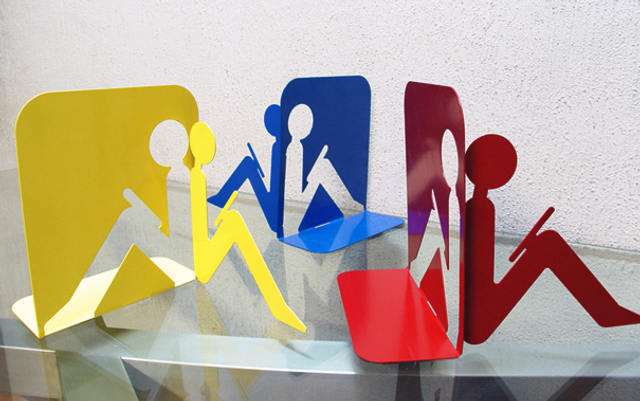
By Cubo3 via BoingBoing, click for more
BoingBoing published this. At first I was interested in bookends depicting someone reading. Then I wondered: What are they reading? The comments suggest others had the same thought. Is it a Kindle or an iPad? somebody wondered. Someone else countered, amusingly, that those devices require hands to use, and these figures lack hands or even arms. So perhaps it’s flat-laid book of poetry. Somebody else noted that some of the angles actually suggest a sort of spy-holding-a-gun pose. And finally: “Those are velcro-backed ebook readers. Stick right to your lap, no hands required. To turn the page, lean forward and tap with your nose.”
I suppose even if the figures are reading electronic devices, these items still require physical books for proper use. Unless we some day have so many devices they are shelved and displayed. Hm.
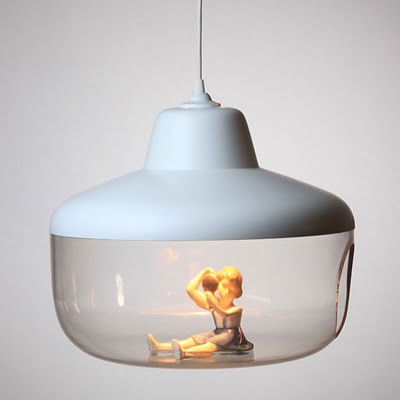
By Chen Karlsson. Click for more.
Junk Culture: “Stockholm design studio Chen Karlsson created a lamp where treasured objects can be exhibited inside a transparent tank beneath the light source. Called Favourite Things, the design is meant to spotlight objects of importance to the owner.”
Thx: Gabriel. Seen also on Significant Objects. Part of an occasional series.
Posted Under:
Things/Thinking by Rob Walker on April 13, 2010
Comments Off on Pictures of Stuff, cont’d: Spotlight for stuff
- Twitter Has a Business Model: ‘Promoted Tweets’: “Will put ads on Twitter, first in search results and later in user feeds both on Twitter.com and the myriad third-party clients that access the service.” Starbucks, Virgin America, Bravo to participate. Once again: Information wants to be ad-supported.
- ideal bookshelves: Design*Sponge notes upcoming show of “ideal bookshelves” works by Jane Mount (noted here) at The Curiosity Shoppe.
- On Being Good at Seeming Smart: The “paraphernalia” of smartness: “Poise, confidence (but not defensiveness), giving a moderate amount of detail but not too much, providing some frame and jargon, etc. But also, unfortunately, I suspect: whiteness, maleness, a certain physical bearing, a certain dialect (one American type, one British type), certain patterns of prosody.” Via Mind Hacks.
- Visual aesthetics in early computing: 1950-1980. Via Coudal.
- Supertaskers: I’ve read/heard many times that people who think they’re great multi-taskers (especially young people) usually aren’t. But this study says a small slice of the population (less than three percent) really can do two things at once, effectively. Since it’s Time magazine they have to come up with a hype name: “supertaskers.” That aside, the article is interesting. Via Mind Hacks.
- German Firm Wins Right to Make Beer Called ‘Fucking Hell’: Couple of the pix in the slide show are quite excellent.
- The Vintage Price Stickers Pool: On Flickr. A new standard in obsessive documentation of all things visual and consumption related?? Thanks to Shawn W.
- The iPad Luddites: Nicholas Carr: “Progress may, for a time, intersect with one’s own personal ideology, and during that period one will become a gung-ho technological progressivist. But that’s just coincidence. In the end, progress doesn’t care about ideology. Those who think of themselves as great fans of progress, of technology’s inexorable march forward, will change their tune as soon as progress destroys something they care deeply about.”
These links compiled via delicious, and repurposed here with plug-in Postalicious. Not enough stuff? Not the stuff you wanted? Try visiting unconsumption.tumblr.com, murketing.tumblr.com, and/or the Consumed Facebook page.
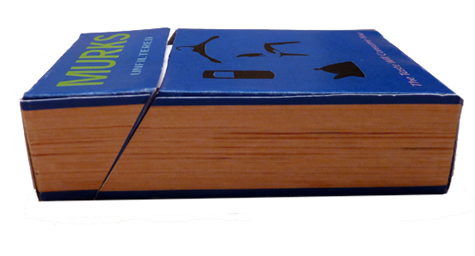
Earlier, the new yet surprisingly comprehensive imaginary-branding-related blog Not A Real Thing made available a template inviting readers to invent their own imaginary cigarette brand. I mentioned it, and to my (happy) surprise, I see that Justin Kirkwood himself has offered up Murks. As he notes, the design is inspired by this site’s rather obsessive cataloging of the idea of the book. (Click either pic for more, and to see his design for a made-up brand of smokes from his spec-screenplay days, Blonde Horses. Nice stuff.)
And yes, that’s right — Murks are unfiltered. The type along the bottom reads: “The Taste Will Consume You.” Yes.
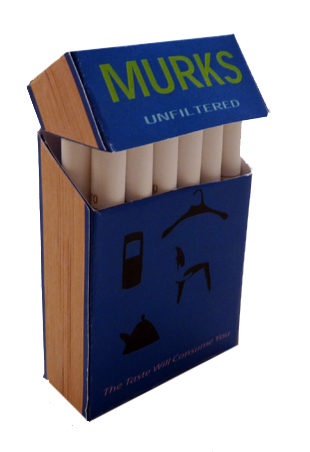
Vis-a-vis hoarding — discussed earlier here and to some extent here (and also in a post on aesthetics of joy) — Salon’s Heather Havrilesky describes the effect that watching hoarding shows has had on her. For example:
[W]hen I watch these hoarders, kvetching over this bag of yarn or that muffin tin, I think about the old black-and-white photographs you sometimes find at flea markets and estate sales, photos of a couple smiling on their couch, or of a gathering of women in a backyard, holding a miserable-looking baby, or of a girl sitting on a swing, a dog wandering through the grass nearby.
These are someone else’s memories that were packed away in boxes, in an attic or a basement, and when that person died, no one wanted them. No kids, no sisters, no spouse, no second cousins showed up and dragged these photographs away — they were left in a pile somewhere, and now here they are, being sorted through by total strangers. How much stuff will I force my kids to sort through? How much of it will immediately be identified as worthless? How much of my stuff might end up like this, drifting through the hands of strangers? When you think about your stuff that way, 90 percent of it suddenly begs to be boxed up and driven to Goodwill immediately.
I know what she’s saying, although when I follow this line of thought it usually ends with me wanting to obliterate all material traces of myself, rather than cart them to Goodwill so they can end up precisely the Stuff Ecosystem described here, to be mused over by strangers after I’m going.
But possibly that’s just me.
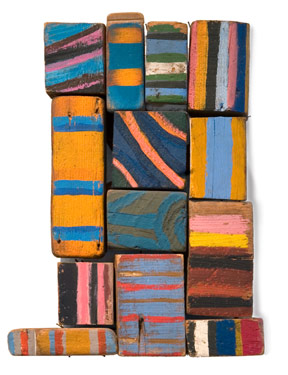
Betty Parsons. Click for more.
A Betty Parsons piece made from “carpenters’ throwaways.” Via Junk Culture. Part of an occasional series.
Posted Under:
Artists,
Unconsumption by Rob Walker on April 12, 2010
Comments Off on Pictures of stuff, cont’d: Throwaway wood art
Spotted in the April 2010 issue of The Atlantic (go buy a copy so they don’t make me cease-and-desist this image!). Part of a series.

Posted Under:
Things/Thinking by Rob Walker on April 12, 2010
Comments Off on Books, the idea, cont’d: Amusing Atlantic cartoon
A few images from a Flickr set by sarcoptiform, courtesy of Shawn Wolfe. Part of a series.
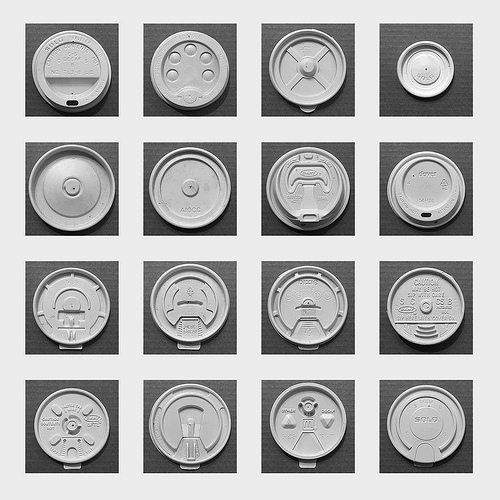
Take Out Beverage Lids
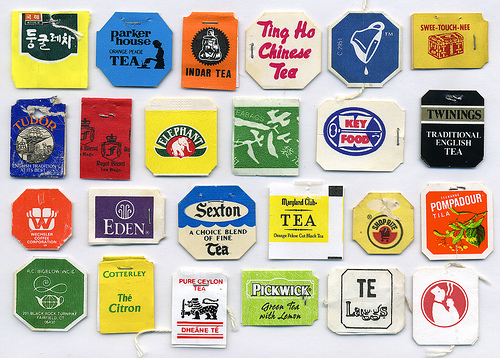
Tea Tags Assortment
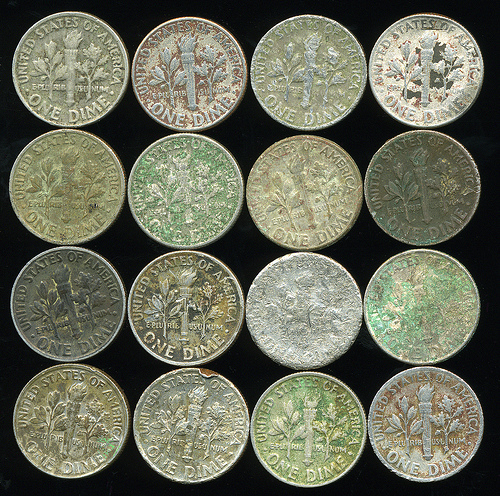
Tarnished Dimes
Posted Under:
Pleasing by Rob Walker on April 11, 2010
Comments Off on Pictures of stuff, cont’d: Take-out lids, etc.
San Francisco singer-songwriter Sonny Smith has a project called 100 Records: He made up 100 fake bands/artists, and wrote songs, created backstories, and so on, for each. An exhibit featuring the covers of the 100 records that resulted is at Gallery 16 in SF. I think this is the related blog. More info here, and here.
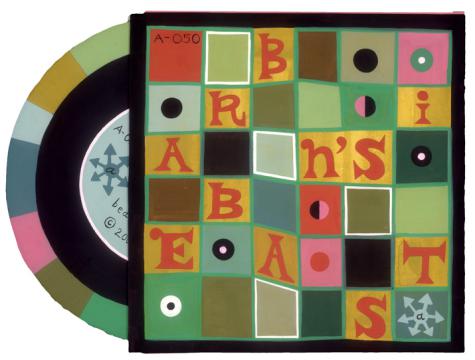
Thanks: Steve P.!
 IPAD ENVY
IPAD ENVY
Giving early adopters what they want.
What these people are likely to get for their consumption daring is a chance to experience every single glitch or flaw that will be tweaked and patched in the months ahead. Also the guarantee that they’re paying full price (just like the early adopters who paid $600 for an iPhone in June 2007; the price was cut to $400 two months later, and angry adopters were mollified by a $100 store credit ). And how surprised will they be if a year from now Apple introduces a new, cheaper and decisively better iPad? Sure, they get first-on-the-block bragging rights — assuming that it turns out iPad adoption proves worth bragging about. Somebody was first to buy the Newton, the Edsel and any number of other products that we don’t even remember the names of anymore, because later adopters never materialized….
Read the column in the April 11, 2010, New York Times Magazine, or here.
Discuss, make fun of, or praise this column to the skies at the Consumed Facebook page.
Posted Under:
Consumed by Rob Walker on April 10, 2010
Comments Off on In The New York Times Magazine: Early adopter = sucker move?
- The iPad Luddites: “Progress may, for a time, intersect with one’s own personal ideology, and during that period one will become a gung-ho technological progressivist. But that’s just coincidence. In the end, progress doesn’t care about ideology. Those who think of themselves as great fans of progress, of technology’s inexorable march forward, will change their tune as soon as progress destroys something they care deeply about.”
- Cildo Meireles’s Coca-Cola Project: “Meireles removed Coca-Cola bottles from normal circulation and modified them by adding critical political statements, or instructions for turning the bottle into a Molotov cocktail*, before returning them to the circuit of exchange.”
- Branding Deals Come Early in the Filmmaking Process – NYTimes.com: Now, having Campbell’s Soup or Chrysler associated with your project can be nearly as important to your pitch as signing Tom Cruise.
- 200 Examples of anti-Obama merchandise: During health care debate, 2008-2010. Via Coudal.
These links compiled via delicious, and repurposed here with plug-in Postalicious. Not enough stuff? Not the stuff you wanted? Try visiting unconsumption.tumblr.com, murketing.tumblr.com, and/or the Consumed Facebook page.
Friend of Murketing Randy Ludacer points out two pieces by Steve Roden that are relevant to this site’s occasional series on the idea of the book.

Steve Roden. Click for more.
From 1999, a piece called Observatory.
the piece was inspired by a quote from joseph cornell’s diary regarding the 5 things he always saw from his kitchen window. he oftern referred to his kitchen as his ‘observatory’. 5 tape loop compositions were composed; each using one of cornell’s 5 things seen. there were electronically transformed tape loops from the sounds of birds, trees, sun (in this case the sounds of the sun harnessed through a magnifying glass burning a contact mic), snow (tv static) and rain.
each of the 5 loops was placed in a cassette player that was concealed in a hollowed out book. each book had a speaker embedded in its spine, so that the audio equipment was concealed and the sounds seemed to quietly eminate from the books. MORE
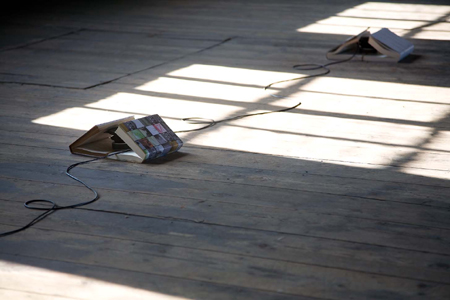
Steve Roden. Click for more.
And from 2008: “When books are like butterflies.”
i began by notating every sound in the book as well as every color that appears in sequence, and used these lists to generate a sound work, a text work, and a set of images. the installation consisted of a series of 15 sculptural forms, each using two books and an audio speaker. the text and images exist in the form of printed dust jackets which cover the books, and visually frame the sound as it eminates from the speaker. the text follows the description of every sound in the book, in sequence, with each text also following the color sequence of the book. the images are mostly background images from victorian photographs i have collected over the years, that somehow relate to the generator of every sound in the text (such as swan’s wings, or a bell). MORE

Steve Roden. Click for more.
Posted Under:
Artists,
Music by Rob Walker on April 8, 2010
Comments Off on The idea of the book, cont’d: As source of music
I mentioned that I’d have a couple of bits of news from the Significant Objects project that might be of interest to Murketing readers. Here’s one bit.
Today’s story (part of our Paola Antonelli team up, co-published on Core77) is by Matt Brown. I’ve mentioned him a couple of times here in the past; a post on Metafilter described him as a “design fiction enthusiast,” which sounded close enough to my interest in imaginary brands that I was curious. And his work just completely blows me away: He has a peculiar genius for devising alternative histories for random, mass-produced stuff, and expressing this design fiction with both words and, more unusually, completely invented packaging. (In fact he’s now doing a series for Core77, Design Fancy.)
We knew we wanted him involved in Significant Objects. And when Paola Antonelli presented me with her objects, there was one that struck me as being perfect for Brown. This:

What is it? Well, Anotelli wouldn’t tell me. Turns out Brown, as I suspected, had an answer. It’s a “crumpter.”
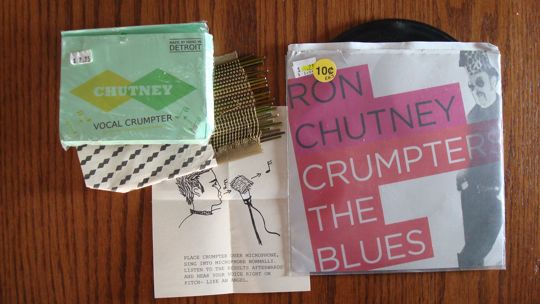
A crumpter, it turns out, is a sort of analog precedent to autotune. Never heard of that? Oh, well then, please read the story over at S.O.
And yes, all the collateral material Brown created is part of the auction.
We’ve sold a mystery object, we’ve sold a story that was itself an object, and now an object whose story is told in part through its packaging.
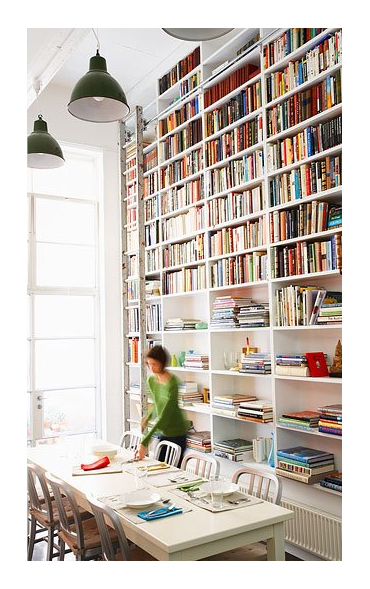
Dining room designed by Diane Bergeron Interiors. Click for more info.
Posted Under:
The Designed Life by Rob Walker on April 7, 2010
Comments Off on Books, the idea: The classic book wall
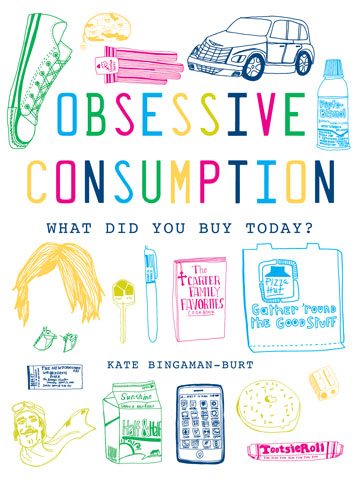
Kate Bingaman-Burt’s book. (Click pic for details.)
So above is the cover of Kate Bingaman-Burt’s new book. Below are some of the interpretations by assorted artists who love her.
I have NO IDEA how it feels to be on the receiving end of an astonishing creative outpouring such as this.
AMAZING.

Frank Chimero
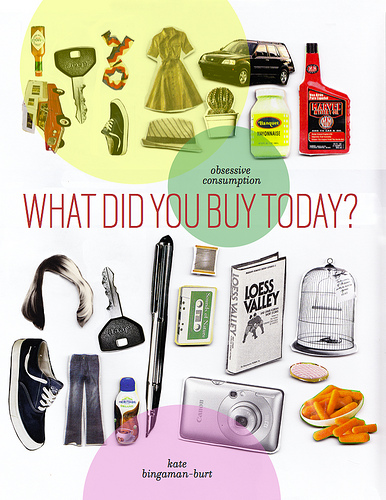
Lis Charman
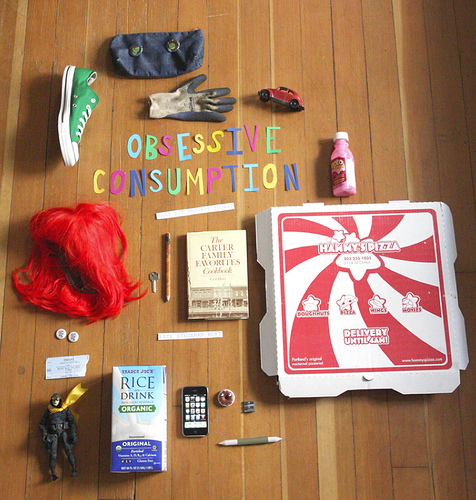
Lucy Berkley
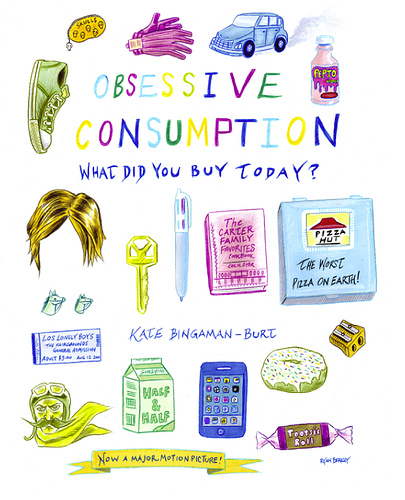
Ryan Berkley
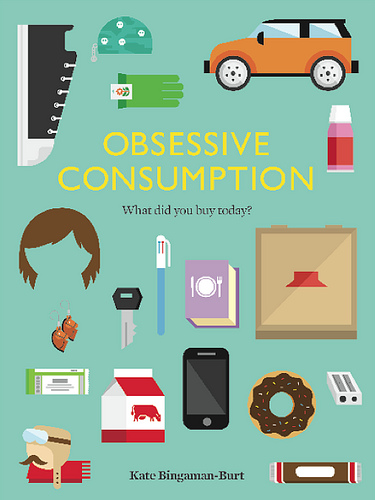
Always With Honor
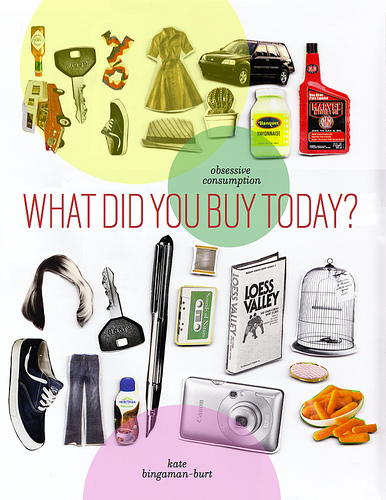
Lis Charman
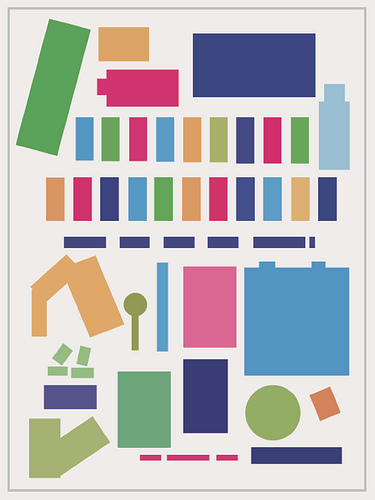
Jason Sturgill

Amy Ruppel
Posted Under:
Artists,
Pleasing by Rob Walker on April 6, 2010
Comments Off on Pictures of Stuff: pictures of pictures of stuff edition




 "
"










 IPAD ENVY
IPAD ENVY


























 Kim Fellner's book
Kim Fellner's book  A
A